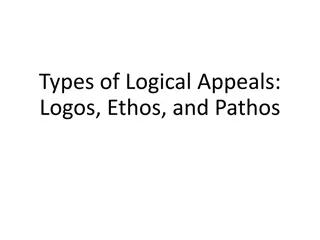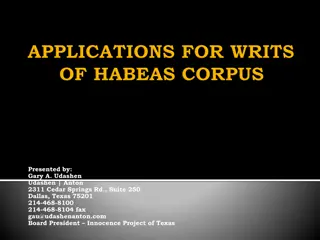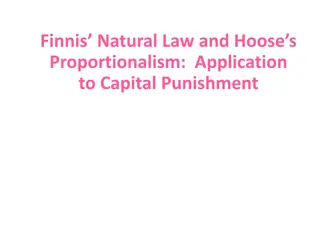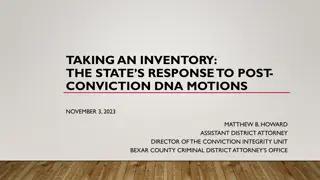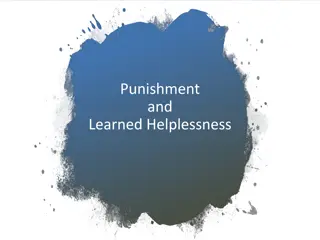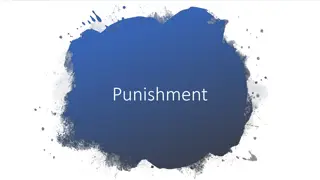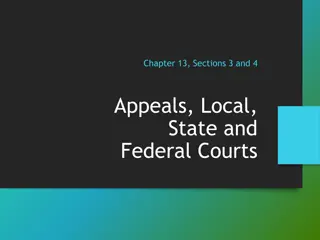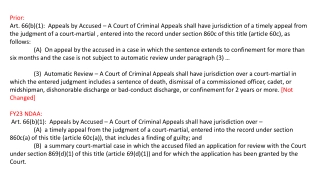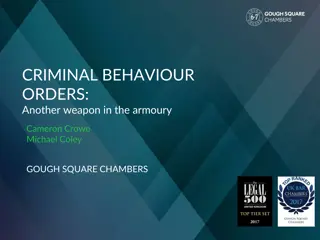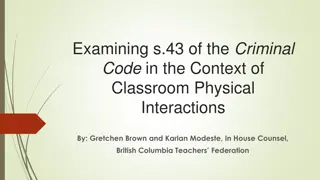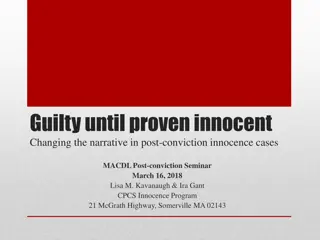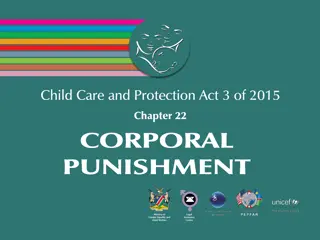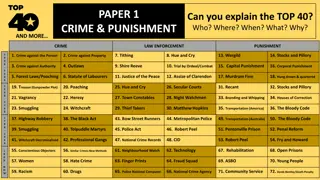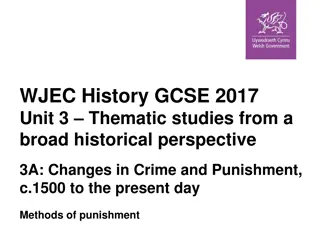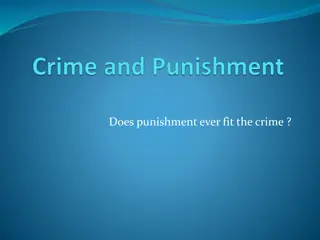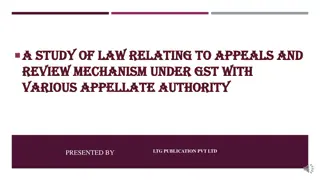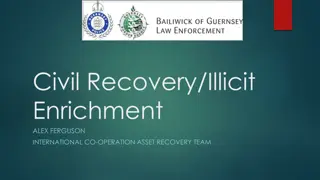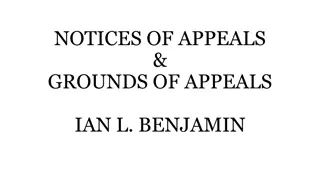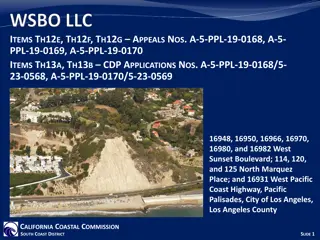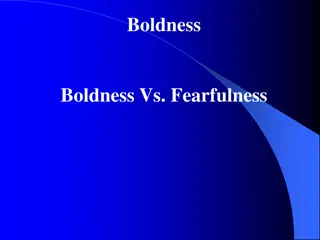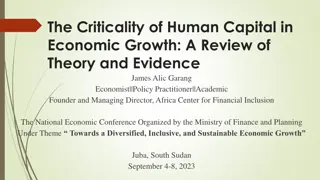The Capital Punishment Process: Aggravators, Mitigators, and Post-Conviction Appeals
The continuation of the discussion on the capital punishment process, specifically focusing on the bifurcated trial, the consideration of aggravators and mitigators, post-conviction appeals including direct appeal and Habeas Corpus appeals, and the importance of proportionality review in state supreme courts. The complex decision-making processes and legal standards involved in death penalty cases are highlighted, emphasizing the challenges and areas of concern within the system.
Download Presentation

Please find below an Image/Link to download the presentation.
The content on the website is provided AS IS for your information and personal use only. It may not be sold, licensed, or shared on other websites without obtaining consent from the author. Download presentation by click this link. If you encounter any issues during the download, it is possible that the publisher has removed the file from their server.
E N D
Presentation Transcript
Deadly Justice, Ch 2 The Capital Punishment Process (cont.) Today we ll complete the material from last week and talk about some current events in Kansas, a challenge to the entire state death penalty system. Don t worry, this seeming detour is directly related to what we re going to be discussing about homicides v. death cases. Baumgartner, POLI 203, Spring 2022 1
The bifurcated trial First: Trial of guilt Result: guilty, not guilty, guilty of a lesser crime If guilty of a lesser crime or not guilty, that s the end If guilty of a capital offense: Second: Penalty phase Immediately following the finding of guilt Same jury, judge, attorneys on both sides Georgia model: weight the aggravators and mitigators Texas model: assess the special issues , esp. future dangerousness Baumgartner, POLI 203, Spring 2022 2
How many aggravators = a mitigator? No guidance. States can list the aggravators. See appendix A, on the book website, for a list of aggravators. Kill a child, a police officer, things like that. These tend to be explicit, though they can be vague ( especially cruel and heinous is a common one, including in NC) There may not be a full list of mitigators. The state can mention things like child abuse, mental illness, mental state at the time of the crime, but there can be no complete or exhaustive. The USSC has ruled that the jury may exercise its mercy for any reason at all. McGautha v. California (1971): really no guidance at all about how to make this life and death decision. Let that sink in. Baumgartner, POLI 203, Spring 2022 3
Post-conviction appeals Part I. Direct Appeal (Automatic) No one can be executed before a full review through the state system, AS WELL AS federal review Automatic appeals through the state appellate system (depends on state) up to the state Supreme Court (or equivalent) Automatic review by a federal district court as well, possibly appealed to USSC. (If direct appeals are unsuccessful, execution can potentially follow.) Part II, Habeas Corpus appeals, not guaranteed but still available based on an argument that there was a constitutional flaw in the trial. These are unlimited, but you can t raise the same one twice, and in 1996 the Anti- terrorism and Effective Death Penalty Act limited them severely. State Federal 70 percent of death sentences are reversed on appeal (many are then reimposed, and re-litigated on appeal; 70 percent of THOSE are reversed.) Baumgartner, POLI 203, Spring 2022 4
Proportionality review State supreme court, on direct review, must assess whether the death sentence is proportionate to the crime. Social science standard: evaluate all the crimes, see if people with similar crimes got similar punishment. Legal standard: see if there are any other cases where someone got death for a relatively similar crime. We ll come back to this, but it s a huge area of failure. There are so many homicides, many of them terrible, but for many reasons the killers do not get death. Those who do get death may or may not be guilty of the most heinous crimes. There are so many heinous crimes! The court did mandate proportionality review in Gregg, however. Baumgartner, POLI 203, Spring 2022 5
Process (cont.) Death warrant: Governor (or attorney general, or warden) sets a date for the execution. Generally six weeks in advance, sometimes years in advance (Ohio). Stay: it s delayed for more appeals. (Most death warrants are not carried out; is that torture?) Clemency: Governor reduces the sentence to life (was once common before WW2, now very rare) Exoneration: one or another of the appeals is successful, and you are not re-tried; you go free! Note, there is no demonstration of innocence, and often not even an apology (DPIC currently lists 186 people exonerated; https://deathpenaltyinfo.org/policy-issues/innocence- database) National Registry of Exonerations lists thousands, including lesser crimes: https://www.law.umich.edu/special/exoneration/Pages/about.aspx Pardon: you re still guilty, but sentence eliminated (generally for low level crimes, not murder). Pardon of innocence: you ve been found innocent or have been exonerated, and the governor issues you this as an affirmative finding of your innocence, otherwise impossible in the judicial system. Official / prosecutorial immunity: very hard to hold a judge, DA, or other accountable if an exoneration case is based on misconduct. Waiving the right to appeal: Suicide by government (see Dylan Roof); about 10 percent of all executions have been volunteers ) Baumgartner, POLI 203, Spring 2022 6
To summarize: Which crimes are capital? State must determine Am I charged with a capital crime? DA must notify. If so: Death qualification of jury, more peremptory strikes High chance of a plea agreement to lesser punishment Perhaps, enhanced legal representation (depends on time, state) Bifurcated trial: Guilt phase, punishment phase Post-conviction review State proportionality review Direct (automatic) appeal to state through to the state SC; also federal review after this is over. Habeas review State determines execution queue; some are fast, some very slow. Baumgartner, POLI 203, Spring 2022 7
Death Is Different The Court has ruled that the new death penalty had to have special safeguards, not available where the penalty is lesser Result: a massive mess, huge delays, 70 percent of cases overturned, huge costs, more rights to the defense, and very few executions get carried out. Danger / risk of executing an innocent, which no one wants. So efforts to streamline have not been successful, even when tried. For example, the 1996 AEDPA was designed to jumpstart the system, but did not. In NC, the 2012 Restoring Proper Justice Act had a similar intent, but has not done so as yet. So, as we evaluate, we have to evaluate the complicated, messy system we have, not the one we think we might like to have. Baumgartner, POLI 203, Spring 2022 8
Kansas death penalty litigation Henderson Hill (look him up) came to class last time. He was the atty for Curtis Flowers in Mississippi (look that up). Walking him back to the car (took half an hour since he parked near the Hospital!). Thanks for coming. What can I do in return? Study Kansas. A judge in Kansas has scheduled a hearing for this April, scheduling an entire week to review whether the system is constitutional under the KS constitution. Where did that come from? Baumgartner, POLI 203, Spring 2022 9
The Kansas Constitution Bill of Rights, section 1: 1. Equal rights. All men are possessed of equal and inalienable natural rights, among which are life, liberty, and the pursuit of happiness. (1859) Can you have the death penalty if your constitution guarantees the inalienable right to life ? (Note: this right is not in the US Constitution; it s in the Declaration of Independence.) Baumgartner, POLI 203, Spring 2022 10
Some background KS was the last state to adopt the death penalty following Furman, in 1994, at the peak of the national tough-on-crime trend. 15 people have been sentenced, 9 remain on death row, none have been executed. Last executions in KS: 1965 Two parolees hanged on April 14 Two soldiers hanged on June 22 All four were white, all four convicted of robbery-murder. The last execution before Furman was in 1967; there were only 4 more in the entire country after June 22, 1965 when KS carried out two. Baumgartner, POLI 203, Spring 2022 11
Hodes v. Schmidt (2019) The right to an abortion is guaranteed by section 1 of the KS Bill of Rights. Let s read that one again! The justices ruled that the right to life includes the right to control one s life and body. Seeing that ruling, Henderson Hill, Cassie Stubbs, and others thought: Maybe this is a good time to ask for a review of the death penalty! Baumgartner, POLI 203, Spring 2022 12
But wait, a setback just the other day. Last week, the KS SC ruled against two brothers who had appealed their death sentences under Section 1 of the KS Bill of Rights, and on other grounds. See the class website for some links to news stories and to this decision. Baumgartner, POLI 203, Spring 2022 13
What is an inalienable right? This ruling says that the inalienable right to life guaranteed in Section 1 of the KS Bill of Rights / Constitution does not mean you can't forfeit your life - you just can't alienate it. Lots of the decision is based on a review of legislative debates and even the political theories of John Locke and William Blackstone, British philosophers whose ideas were thought to have influenced thinking back in 1859 when Kansas adopted its constitution. Baumgartner, POLI 203, Spring 2022 14
What did William Blackstone think? Like Locke, and consistent with delegate Kingman's interpretation of section 1, Blackstone recognized the right to life is not alienable, meaning it cannot be assigned or transferred to another, but it can be forfeited when a person's criminal conduct necessitates punishment, up to and including capital punishment, in civil society. (State v. Carr, p. 34) Baumgartner, POLI 203, Spring 2022 15
Where did Blackstone get this? Quoting the majority opinion again: "With regard to offences mala in se, capital punishments are in some instances inflicted by the immediate command of God himself to all mankind; as, in the case of murder, by the precept delivered to Noah, their common ancestor and representative, 'whoso sheddeth man's blood, by man shall his blood be shed.'" 4 Blackstone, at 9. (State v. Carr, p. 36). So here we can get a feel for what original intent means Baumgartner, POLI 203, Spring 2022 16
One judge dissented on the need for the history lesson: "I hope those reviewing my colleagues' history lessons will accept the exercise for what it obviously is hard working judges trying to honestly answer the questions presented in good faith. But for me, an originalism search gets us only so far when divining meaning for words with such obvious open-ended qualities as 'liberty' or 'inalienable natural rights.' The historical back-and-forth really just boils down to how much weight is given one selected fact over another."(Biles, J, dissenting, State v. Carr, p. 145) But he agreed with the ruling; if you kill you forfeit the right to life, as decided in a previous Kansas case, State v. Kleypas (2001). Baumgartner, POLI 203, Spring 2022 17
Procedural errors Carr alleged a large number of procedural errors at his trial, and the State v. Carr decision recognized that a number of those allegatios were accurate. The majority said, however, that even the accumulated impact of all these errors together would not have changed the jury decision. One justice dissented: Given the nature and volume of errors, I cannot eliminate the possibility that at least one juror would have decided mitigating factors or mercy outweighed the aggravating factors put forward as reasons to sentence Reginald Carr (R. Carr) to death. (Justice Luckert, dissenting in part, State v. Carr, p. 150). But he agreed with the rest of the decision, particularly the main part. Baumgartner, POLI 203, Spring 2022 18
So where do we stand in Kansas? Seems clear the Court is backtracking seriously from the Hodes decision. What if the system can be said to serve no useful purpose? What if it s biased with respect to race or gender, or both? What if it s geographically arbitrary? What if it s not targeted at the worst of the worst? The litigation will focus on these and similar practical matters. Baumgartner, POLI 203, Spring 2022 19
Strict scrutiny Given that there is a fundamental right to life, the state cannot take that away without clearly demonstrating a compelling interest or a high value to the community that would out-weigh the individual right in the constitution. In other words, the strict scrutiny standard allows a challenge by showing that there is no benefit to the state: no deterrence, no increased safety, no increase in community safety, etc. Baumgartner, POLI 203, Spring 2022 20
What do the data show about Kansas death penalty? Category Total by Offenders By Offender Gender Female Male By Offender Race Black White By Offender-Victim Race Combinations Black kills Black White kills Black White kills White Black kills White Black male kills White female Homicides Death Sentences 2014 100 15 100 211 1535 10.5 76.2 0 - 15 100 675 996 33.5 49.5 3 20 80 12 447 103 842 202 22.2 5.1 41.8 10 0 1 - 6.7 66.7 20 10 3 66 3.3 2 13.3 Baumgartner, POLI 203, Spring 2022 21
Who is victimized by homicide? Which cases go to a death sentence? Women: 26% of homicides, 66% of DS Blacks: 35% of homicides; 6% of DS Baumgartner, POLI 203, Spring 2022 22
Victim race and gender matter a lot Not a single death case has had a black male victim. Baumgartner, POLI 203, Spring 2022 23
Another way to look at that same data; note the last section, offender- victim combinations Baumgartner, POLI 203, Spring 2022 24
Next steps (I need help!) Maybe this comes from enhanced media coverage of white victim cases. Carr brothers case: it hit every cultural stereotype. It also led to huge amounts of news coverage, very high profile. Therefore very political. Hard for the justices and the DA to avoid the political implications. For 25 capital cases, we need to find the amount of media coverage. See me if you have time to help with this in the next 10 days. Baumgartner, POLI 203, Spring 2022 25



